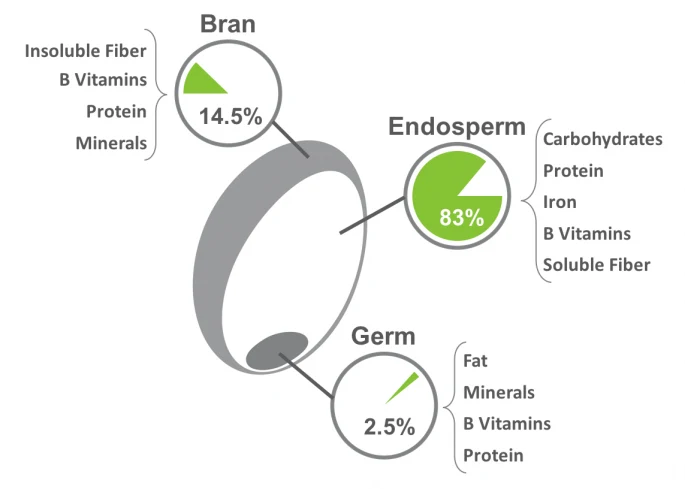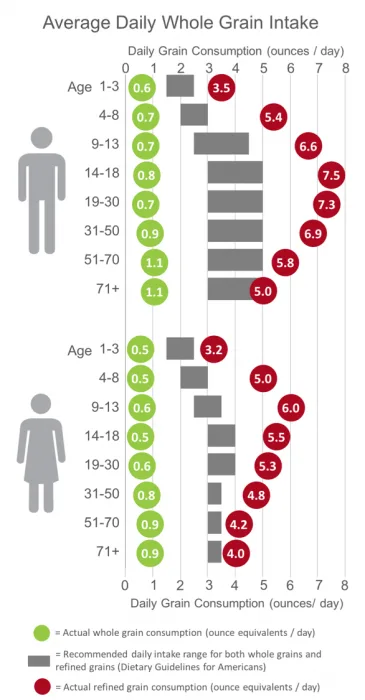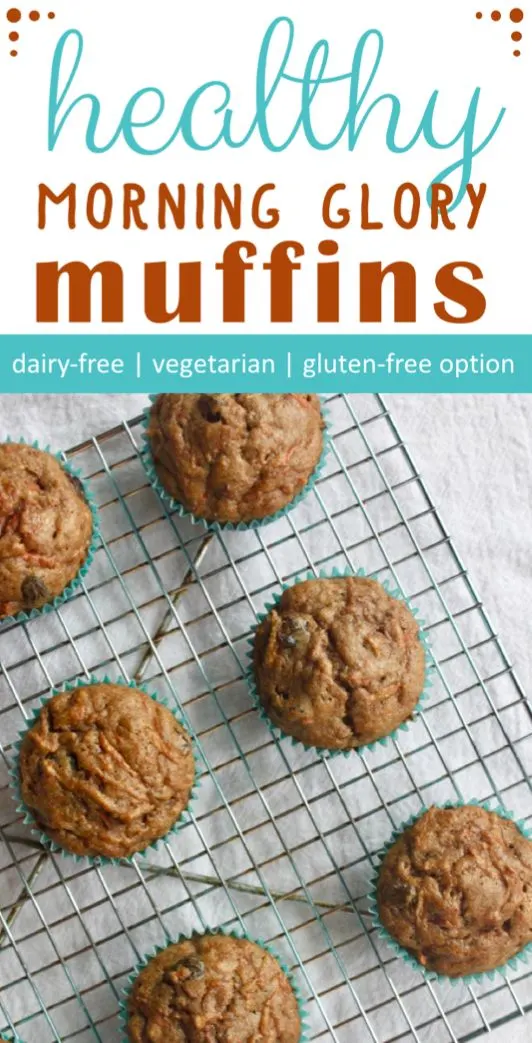Many packaged cereals, breads, and grain-containing foods highlight their whole grain content. “Whole grain” may even be in the product’s name. What exactly are whole grains and why is it important that we eat enough of them?
What are whole grains?
Whole grains contain the entire grain seed, typically called a kernel. A kernel is composed of three parts: bran, germ, and endosperm. Below is a diagram of a whole wheat kernel detailing the relative percentages of bran, germ and endosperm along with the nutrients they provide.(2)

Examples of whole grains include brown rice, whole wheat, popcorn, quinoa and oats. Processed whole grains (cracked, crushed, flaked, or milled) must retain the same relative proportions of bran, germ, and endosperm as the original grain. Many, but not all, whole grains are good sources of dietary fiber.(1)
What are refined grains?
When a grain is refined, the germ and bran are removed leaving only the starchy endosperm, significantly reducing the fiber and vitamin content of the grain (see table below).(3,4) This removal of fiber causes our body to rapidly digest the remaining starchy carbohydrates, resulting in a higher glycemic response that is similar to the glycemic response from consuming table sugar.(5,6)

It is unhealthy to eat too many refined grains
Habitual consumption of too many refined grains can make you more prone to obesity, heart disease, and type 2 diabetes.(6) It is because of these health consequences that the 2015-2020 Dietary Recommendations for Americans recommends a shift to whole grains from refined grains.(7) However, the US Dietary Guidelines do not recommend eliminating all refined grains from our diet for one simple reason: refined grains are typically fortified (or enriched) with key vitamins and minerals and there is concern that nutrient shortfalls could result without consumption of some fortified grains.(1)
Western diets do not contain enough whole grains
On average, our intake of whole grains is far below current recommendations. In fact, most Americans consume less than one 1-oz serving of whole grains each day. And children consume only a half of a 1-oz serving of whole grains each day.(7.8)

The most recent assessment of What We Eat in America (WWEA, a national food survey) found that nearly 100% of all Americans did not meet the daily goal for whole grain intake.(1) This shortfall is not a result of eating too few grains, it is because we are eating predominantly refined grains. In fact, 70% of the US population exceeded the daily recommended intake of refined grains in this survey.(1)
Recommended Servings of Whole Grains
Both the US Dietary Guidelines for Americans and Health Canada’s Eating Well with Canada’s Food Guide recommend eating whole grains for at least half of our daily grain intake.(7,9) For most people, this means eating at least three 1-oz servings of whole grains a day.
The American Heart Association adds to this recommendation by including that the whole grains should be fiber rich, where there is 1.1 grams of fiber for every 10 grams of carbohydrates.(10)
What does a serving 1-oz of whole grains look like?
- ½ cup cooked brown rice
- ½ cup cooked 100% whole wheat pasta
- 1 slice 100% whole grain bread
- ½ cup cooked oatmeal
- 3 cups popcorn
It would be easy to meet the daily whole grain recommendation if our three daily meals each contained one serving of whole grains.
Health Benefits of Eating Whole Grains
There is consistent epidemiological evidence that consuming whole grain foods substantially lowers the risk of chronic diseases such as coronary heart disease, diabetes, and cancer and can also play a role of body weight management and digestive health.(11)
Additionally, there is significant clinical evidence demonstrating that soluble fiber (found in oats, barley, fruits, vegetables, and legumes) can markedly reduce serum total cholesterol and LDL cholesterol and reduce the risk of heart disease.(12,13)
The American Heart Association states that “dietary fiber from whole grains, as part of an overall healthy diet, may help improve blood cholesterol levels, and lower risk of heart disease, stroke, obesity and type 2 diabetes.”(14)
How to Identify Whole Grains
There are currently no requirements to label the whole grain content of a food on its packaging. However, in a recent report, the Institute of Medicine recommended the FDA begin to require labeling whole grain content to enable people to better meet their recommended daily intake of whole grains.(8)
Until the whole grain content of a food is clearly labeled, here are four simple ways to identify whole grains:
- Read the food’s ingredient label. Look for “whole wheat flour” instead of “wheat flour” or “enriched flour.” Wheat flour and enriched flour are both types of refined flour
- Check the Nutrition Facts for dietary fiber content. Whole grain wheat, oats and other grains will contain at least 1 gram of dietary fiber per 10 grams of carbohydrates
- “May reduce risk of heart disease” or “can help lower cholesterol” on the food package (15)
- The food package contains the Whole Grain Council stamp (pictured below, 16)

Replacing refined grains with whole grains is an easy step to eating healthier!
Replacing the refined grains with whole grains is one relatively simple step you can take to eating healthier. Here are some easy ways to eat more whole grains:
- Switch to 100% whole wheat pasta if you are currently eating regular pasta
- Cook brown rice instead of white rice
- Buy bread made from most or all whole wheat flour (it will have whole wheat as the first ingredient on the ingredient list)
- Choose breakfast cereals and snacks that are whole grain rich
Need help choosing foods that are rich in whole grains? Check out our guides to choosing a healthier breakfast cereals and choosing healthier crackers and snacks!
Interested in cooking with more whole grains? Here are some of my family’s favorite 100% whole grain recipes:
References
- Scientific Report of the 2015 Dietary Guidelines Advisory Committee. US Department of Health and Human Services. Washington, DC: US Government Printing Office; 2015. (link)
- Diagram of a Wheat Kernel, California Wheat Commission Website (link)
- King Arthur Flour Website (link)
- Bobs Red Mill Website (link)
- Dietary and Policy Priorities for Cardiovascular Disease, Diabetes, and Obesity, A Comprehensive Review. D Mozaffarian. Circulation. 2016;133:187-225. (link)
- What To Eat, Marion Nestle, 2006 (link)
- Dietary Guidelines for Americans, 2015-2020, Eighth Ed. (link)
- School Meals: Building Blocks for Healthy Children, Institute of Medicine, The National Academies Press, 2009 (link)
- Eat Well with Canada’s Food Guide, Health Canada Website (link)
- AHA 2020 Impact Goals. Circulation. 2010;121:586-613 (link)
- Putting the Whole Grain Puzzle Together: Health Benefits Associated with Whole Grains. The Journal of Nutrition, 2011 (link)
- Diet and Health: Implications for Reducing Chronic Disease Risk, National Research Council Committee on Diet and Health (link)
- Eat for Life: The Food and Nutrition Board’s Guide to Reducing Your Risk of Chronic Disease, The National Academies Press, 1992 (link)
- Whole Grains and Fiber, American Heart Association Website (link)
- Requirements for health claims based on soluble fiber of a food, FDA website, eCFR §101.81, §101.77, (link)
- Whole Grain Council Website (link)
This article was originally published in March, 2017. This current version has been updated to improve readability and include a charts highlighting whole and refined grain consumption.





